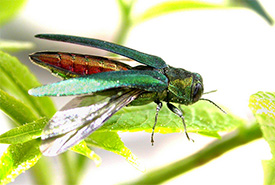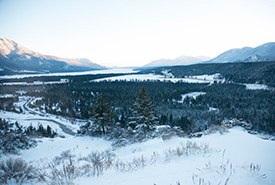Three reasons why it’s important to study winter

Me, my husband and dog bundled up during the polar vortex (Photo courtesy of Meghan Duell)
We tend to think of winter in temperate regions as cold, maybe snowy, maybe grey and with short daylight hours. Maybe you hate winter because you dislike feeling cold, having chapped skin, driving on icy roads and...insert weather problem here (for example, snow, ice, sleet, school cancellations). Or maybe you love winter for the outdoor sports, hot chocolate and winter holidays.
The recent polar vortex got members of Brent Sinclair’s low temperature biology lab (the Sinclair lab) at the University of Western Ontario thinking: How can we show just how hard winter is for us and for wildlife?
So I and Alex Torson, the other postdoctoral researcher at the Sinclair lab, searched the internet for headlines related to the polar vortex. We then categorized them so that we and other Sinclair lab members could show the headlines during presentations and have discussions with people who ask why we do what we do. Some of our categories included:
1. Cold versus wildlife
Many animals have to hunker down through the winter to avoid hypothermia and frostbite just like we humans do. Ectothermic (cold-blooded) animals may overwinter actively (they still eat and move around in the cold) or inactively (they stop developing at a certain life stage while they wait until spring to begin to grow again).
There are real medical applications to understanding the physiology of overwintering in animals, such as cryopreservation and improving outcomes for people who suffer heart attacks and strokes. There is evidence that lowering the body temperature of stroke and heart attack patients can limit the damage those events cause. The reason for this is not clear, so this has become an active area of medical research.

Emerald ash borer adult (Photo by by U.S. Department of Agriculture)
Another application of understanding the effects of low temperatures on animal physiology is the extermination of insect pests. There are a number of insect pests that come to mind, several of which the Sinclair lab is currently working on or has worked on. These include emerald ash borer, black marmorated stink bug, Asian longhorn beetle, mosquito, tick and others. Winter conditions may help control these pest populations.
Related blog posts
2. Cold and climate change go hand in hand

Dutch Creek Hoodoos, BC (Photo by NCC)
Extreme cold events truly are indicators that climate change is progressing. This is because of the unique climate circumstances that must be in place in order for a polar vortex to impact major populated regions, which are typically not in the far North.
Research has shown that extreme weather events are the direct result of climate change. By researching overwintering biology, we can understand how these extreme events and the gradual change in winter conditions over many years impact everything from the length of insect life cycles, to the distribution of forest habitats, to the evolution of climate-related traits and human health impacts. Both the impact of extreme weather events and the research are important, and they will affect us for generations to come.
3. Acclimation
Have you ever noticed how that first really cold winter day is really difficult to deal with, but after a few days of them, it begins to feel normal? Or how warm –10 C felt after a few days at –30 C? Yes, you acclimated a little bit to the cold. But how did your body do this? Why is it important that your body did this? Overwintering biologists are at your service to solve these and more puzzles regarding acclimation. Learn about acclimation in freeze-tolerant crickets here.
There are certainly more reasons to care about overwintering biology, but these are some important ones that fit many questions and study systems (that is, the animal species used to study low temperature physiology) in the field.
Read the original blog post, published on Meghan's blog, here.


